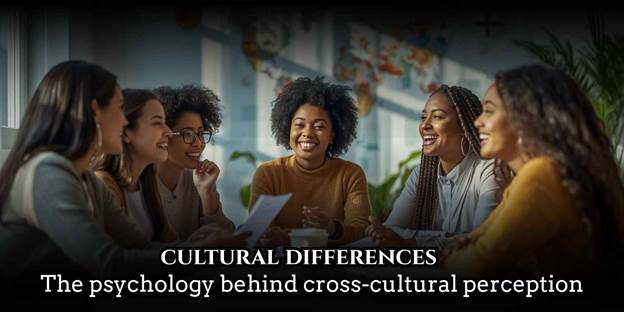Understanding Cultural Differences: A Psychological Perspective
Cultural differences influence how people think, feel, and behave in every social interaction. The psychology behind cross-cultural perception explores how humans interpret and respond to people from other cultures, revealing how deeply our upbringing and cultural norms shape our worldview. This article examines the roots of cultural differences, their impact on social understanding, and the psychological mechanisms that drive empathy, misunderstanding, and connection across diverse societies.

Defining Cultural Differences and Cross-Cultural Perception
Cultural differences refer to the variations in values, customs, communication styles, and behavioral expectations across societies. These differences affect everything from how people express emotions to how they perceive respect, honesty, or success. Cross-cultural perception, on the other hand, is the psychological process of interpreting and understanding people from different cultural backgrounds.
Psychologists suggest that perception is not objective; it is filtered through cultural lenses formed over years of social conditioning. For instance, an act of politeness in one culture may appear distant or insincere in another. Understanding these perceptual biases is essential for effective communication and cooperation in our globalized world.
Historical Context: How Cultural Psychology Evolved
The study of cultural differences in perception began with early anthropologists like Edward Tylor and Franz Boas, who emphasized that behavior and thought are shaped by cultural environments. Later, psychologists such as Geert Hofstede and Shalom Schwartz introduced frameworks like cultural dimensions theory, identifying key variations such as individualism vs. collectivism and high-context vs. low-context communication.
In modern psychology, cultural studies emphasize cultural relativism the idea that no culture is superior, but each has its unique system of meaning. This approach has expanded understanding in fields like intercultural communication, social cognition, and behavioral economics.
How Culture Shapes Perception and Behavior
Cultural differences influence how we see the world literally and psychologically. Our brains are wired to notice patterns and assign meaning based on prior experience. Culture supplies these frameworks, shaping interpretation of language, gestures, and even facial expressions.
Key psychological effects include:
- Selective Attention: People focus on details their culture deems important. For instance, Westerners notice individual objects, while East Asians perceive relationships within the entire scene.
- Cognitive Bias: Cultural norms shape moral judgments and emotional responses, leading to varying definitions of right or wrong.
- Social Identity Theory: Individuals derive part of their identity from cultural group membership, influencing how they perceive outsiders.
These cognitive tendencies explain why misinterpretations often occur during intercultural communication and why empathy and open-mindedness are essential skills.
The Importance of Understanding Cultural Differences
Recognizing and respecting cultural differences promotes global harmony and reduces social conflict. It enhances international collaboration, supports inclusive education, and builds stronger workplaces. In psychology and business alike, understanding cross-cultural perception is key to bridging communication gaps and fostering empathy.
Benefits of cross-cultural understanding include:
•Improved communication and teamwork in multicultural settings
•Enhanced emotional intelligence and cultural empathy
•Reduced prejudice and stereotyping
•Better negotiation and diplomacy outcomes
The ability to interpret others’ behavior without judgment enables societies to thrive in diversity rather than resist it.
Challenges in Cross-Cultural Perception
While cultural awareness has improved, challenges persist. Miscommunication, ethnocentrism, and unconscious bias often distort cross-cultural understanding.
Common obstacles include:
•Assuming one’s own culture is the “standard”
•Misinterpreting nonverbal cues such as eye contact or gestures
•Language barriers and translation errors
•Overgeneralizing cultural traits instead of recognizing individual differences
Psychologists advocate for cultural humility a mindset that encourages curiosity and learning rather than assumptions. Training programs in intercultural competence have proven effective in overcoming these barriers.
Real-World Examples of Cultural Perception in Action
- Workplace Diversity: In multinational companies, employees from collectivist cultures may prefer group harmony, while those from individualistic cultures value personal achievement. Awareness of these dynamics helps leaders manage teams more effectively.
- Healthcare Communication: Cultural beliefs about illness and treatment affect patient-doctor relationships. For instance, indirect communication styles in some Asian cultures may cause misunderstandings in Western medical systems.
- Education Systems: Students from high-context cultures may interpret teacher authority differently, influencing classroom participation and learning outcomes.
Such examples highlight that cultural differences are not barriers but opportunities for growth when understood with empathy.

Bridging the Gap: Strategies for Better Cross-Cultural Perception
To overcome psychological biases and improve understanding, individuals and organizations can adopt the following strategies:
•Active Listening: Focus on understanding before responding.
•Cultural Immersion: Experience other cultures firsthand through travel or community engagement.
•Perspective-Taking: Try to see situations through another cultural lens.
•Intercultural Training: Participate in programs that build awareness and communication skills.
•Mindful Communication: Be aware of tone, gestures, and assumptions.
By practicing these approaches, we can cultivate genuine respect for diversity and build stronger global relationships.
Conclusion: The Value of Cultural Awareness in a Globalized World
Cultural differences shape how we see and interact with the world, but they need not divide us. Understanding the psychology behind cross-cultural perception helps bridge emotional and intellectual gaps between societies. By practicing empathy, curiosity, and cultural humility, individuals can transform differences into opportunities for connection. The more we understand each other’s cultural lenses, the closer we move toward a truly interconnected and respectful world.
1. What are cultural differences?
Cultural differences are variations in customs, communication styles, and values between societies that shape perception and behavior.
2. Why is cross-cultural perception important?
It promotes empathy, reduces bias, and enhances communication in globalized communities.
3. What causes misunderstanding between cultures?
Biases, language barriers, and differing nonverbal cues often lead to misinterpretation.